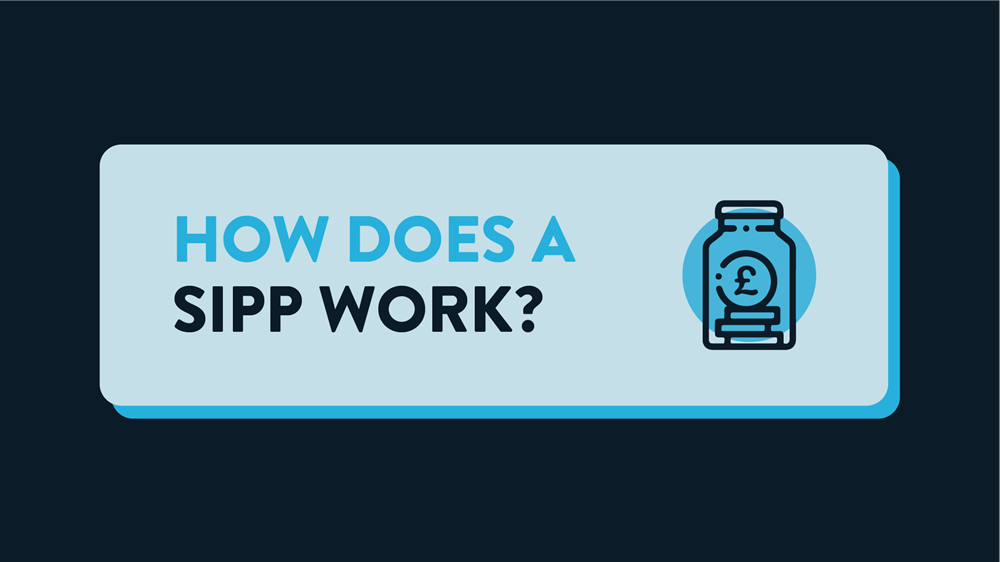We all dream of spending our golden years doing what we love without worrying about money. And even though planning for retirement is no easy task, a Self-Invested Personal Pension (SIPP) could potentially make things easier.
At £230.25 a week and £11,975 a year currently, the full State Pension probably isn’t even going to be enough to cover the minimum living costs you’ll likely face during retirement. [1]
So, it’s important to look at other options that could help you live the retirement you’ve always envisioned — which is where a SIPP comes in.
With that in mind, let’s start with the basics: what is a SIPP, and how does a SIPP work?
What is a SIPP?
A SIPP is a type of personal pension that anyone under the age of 75 can open.
It gives you control and flexibility over your retirement pot, as you can make your own pension contributions.
They're different to workplace pensions in that most SIPPs are funded solely by personal contributions. A workplace pension, on the other hand, is a combination of both you and your employer’s contributions.
Likewise, it’s not the same as the state pension, because that money isn’t determined by your personal contributions; it’s a regular payment you should receive from the UK government once you reach retirement age. How much you get depends on you having paid a certain level of national insurance contributions over your working life.
How does a SIPP work?
Whether you’re looking to make regular or one-off payments, the money you pay into a Self-Invested Personal Pension will typically be invested in a wide range of investments, including shares, bonds, and property.
Although we’ll discuss the benefits in more detail later, one of the main benefits of a SIPP is that you’ll receive a 25% tax relief top-up from the government for personal contributions up to 100% of your UK taxable earnings within a tax year, or £3,600 if you have earnings lower than this amount. Consider it a nice little boost that could help maximise your potential returns over the long-term!
However, it’s important to note that contributions (including those made by your employer) are also limited by the annual pension allowance, which for this current tax year is £60,000 (except for some high earners).
So, if you’re a basic rate taxpayer, for example, let’s say you pay in £80.
The government will then add another £20 in tax relief, turning that initial £80 into £100!
If you’re a higher or an additional rate taxpayer, you could expect to receive an extra boost (although you’ll need to contact HMRC to get the extra top-up).
That’s why, whether you’re employed or self-employed (and a UK resident under the age of 75), investing in a SIPP could be a great way to boost your future retirement income.
The tax treatment of your investment will depend on your individual circumstances and may change in the future.
What are the benefits of a SIPP?
In a nutshell, a SIPP is a beneficial way to supplement any potential state and workplace pensions you might have.
As previously mentioned, one of the main benefits of a SIPP is the government’s 25% top-up, which makes it a tax-efficient way to build your retirement pot.
On the subject of SIPPs being tax-efficient, another benefit is that you don’t pay capital gains or income tax on your investments as they grow, meaning you get to keep more of your profits for retirement.
One of the other things we love about SIPPs is the flexibility they offer.
By being able to choose the exact amount and how often you want to contribute, a SIPP lets you take control of your retirement on your terms!
And, if you’re self-employed, this is particularly important, as you don’t have an employer to choose a pension scheme or make contributions for you.
Flexibility also means having access to a wide range of investments, such as shares, bonds, and property. When setting up a SIPP, you can choose to do this in one of two ways:
- Do it yourself and pick your own investments — although this strategy can be time-consuming and typically requires some investment knowledge.
- Use an online service like Wealthify, where everything is managed for you from start to finish — including where your money gets invested based on your chosen investment style.
SIPP tax considerations
It’s important to note that Personal pensions carry specific tax implications that you should be aware of:
- Contributions to your SIPP may be eligible for tax relief, but income withdrawals are typically subject to tax. However, the first 25% of your withdrawals is usually tax-free.
- If you withdraw funds before the age of 55 (or the minimum pension age), you could face tax penalties and additional charges.
- Exceeding your annual pension allowance may also result in tax charges.
- If you die before age 75, your beneficiaries will not have to pay tax on anything they withdraw. However, withdrawals made if you die after 75 years old are taxed as income.
If possible, please consult a financial professional to understand how your personal pension decisions will affect your tax position and retirement plans. You can also visit Money Helper for free impartial guidance that’s backed by the government.
How much can I pay into a SIPP?
Each tax year, you can put as much as you want in your SIPP.
However, for most people, the amount you’ll get tax relief on is limited to £60,000, or 100% of your earnings (whichever is lower). This pension allowance is the combined contributions made by you, the government and your employer.
For instance, let’s say you earn £30,000 a year, but put £35,000 into your pension pot (because you’ve dipped into your savings), you’ll only get tax relief on £30,000. However, some providers may limit the amount that you can put into your pension pot to a maximum of 100% of your UK earnings.
Can I have more than one SIPP?
Thankfully, there’s no limit to how many SIPPs you can have. However, you can only open one SIPP with Wealthify.
There is also a limit to how much you can save tax-efficiently in SIPPs each year. This limit is the same as the amount outlined in the section above.
Can I have a SIPP and a workplace pension?
Yes, you can.
In fact, if you are in a position to contribute towards both, you’ll be taking advantage of employer contributions with your workplace pension — and the government’s 25% top-up with personal contributions to your SIPP!
You can compare both in more detail by reading our pension guide.
When can I access my SIPP?
As things stand, you can access the money you’ve put into a SIPP aged 55; in 2028, however, this will increase to 57.
Once you have turned 55, you’ll have the opportunity to take up to 25% of your pension money as a tax-free lump sum. After that, you can still start making further withdrawals from a SIPP even if you’re still working (although these will be subject to tax), and you can keep paying into one until you’re 75.
Can I transfer my SIPP to another provider?
As well as being able to transfer your old workplace pension to a SIPP, you can also transfer a SIPP to another provider.
There might be several reasons why you might do this, including better fees and service.
To get the ball rolling, you’ll need to find your pension(s) and any appropriate documents. From there, simply contact your new provider and let them know you want to transfer.
You’ll need to give them some basic information, including who your current provider is, your reference number, and an estimated value of your pot. These details can easily be found on your latest pension statement.
Your new provider will then contact your old provider to get the transfer process started!
You may also have to get in touch with your old pension provider yourself, especially if they object to the transfer or need further confirmation.
You’ll be told if this happens, however, and your new pension provider should be in touch with you if anything is needed from you.
If you’re looking to transfer your pension(s) to a Wealthify Self-Invested Personal Pension, you can learn more about that process on our pension transfer page.
How to set up a SIPP
If you’re looking to set up a Wealthify Self-Invested Personal Pension from scratch, then we’ve made that easy, too!
Three simple steps are all it takes:
- You Choose: From Cautious to Adventurous, Original or Ethical; start by telling us what type of investment style you want to choose.
- We Invest: Once we’ve established your investment style, our experts will build your Personal Pension Plan with just the right mix of investments.
- We Optimise: You then leave all the heavy lifting to us, as we monitor your Pension Plan and manage everything for you.
The Self-Invested Personal Pension we offer is a defined contribution scheme, which means your pot size is what you’ve put in, plus any growth defined by the contributions made.
In other words, when the time to access and use your pension pot comes, you’ll be able to choose between taking your whole pension as a lump sum in one go, withdrawing lump sums when you need them, or getting paid a regular income based on your pot size.
Whatever option you go for, you’ll be able to take up to 25% of your pension pot tax-free.
If you’ve made it this far, we’re hoping this article has helped answer your original question of: how do SIPPs work?
However, if you do still have any questions about a Wealthify Self-Invested Personal Pension, then please don’t hesitate to contact us by sending us a secure message, using the live chat feature on our website or calling us on 0800 802 1800.
Your tax treatment will depend on your individual circumstances and it may be subject to change in the future.
With investing, your capital is at risk, so the value of your investments can go down as well as up, which means you could get back less than you initially invested.
Wealthify does not provide advice. If you’re not sure whether investing is right for you, please speak to a financial adviser.
References:
[1]: Government website - New state pension: What you'll get



